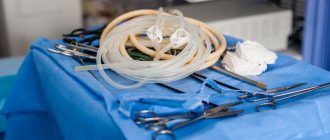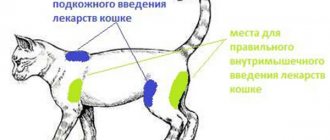Contrary to popular belief, the terms castration and sterilization are in no way related to the sex of the animal and imply various types of surgical interventions aimed at preventing unwanted reproduction of animals. Males and females can be castrated, as well as sterilized: in both cases, they lose the ability to reproduce.
Sterilization (vasectomy) is a surgical operation whose purpose is to create a barrier to the movement of cells involved in conception. In female animals, the fallopian tubes are ligated (this prevents the egg from getting from the ovaries to the uterus), and in cats and male dogs the spermatic cords are ligated, which prevents the release of sperm. During surgery, the genitals are not affected and continue to function as usual. Since hormonal levels are not disrupted, sterilized cats and dogs fully retain all instincts and the ability to mate, but pregnancy does not occur for obvious reasons.
Castration (ovariohysterectomy) – removal of the organs of the reproductive system: the uterus and ovaries (in cats and females) and testicles (in males and males). A variation of this operation is oophorectomy - removal of the ovaries while preserving the uterus. This practice is becoming increasingly rare: due to the high risk of complications and the development of cancer, the uterus is removed along with the ovaries.
To castrate or sterilize: that is the question
Owners of sterilized animals note that after the operation the behavior of their pets practically does not change, because the level of sex hormones remains at the same level. However, this does not mean that sterilization occurs absolutely without consequences for the animal’s body. At certain moments, real hormonal explosions can be observed when hormone concentrations approach critical values. Sterilized dogs and cats are more susceptible to stress and diseases of the genitourinary system. Significant changes are also observed in behavior: animals often become aggressive, are more difficult to train, and often lose weight for no apparent reason. According to statistics, more than half of animals with oncological pathology of the genital organs were previously sterilized.
Castration is the “gold standard” of veterinary medicine with minimal consequences for the risk of developing cancer of the uterus, ovaries and testicles. In 90% of cases, castration helps to cope with behavioral problems: aggression, dominance, increased excitability.
It has been proven that the life expectancy of neutered cats and dogs increases by an average of 1-3 years, and for some age-related diseases, castration is the only way to save a pet. Castration completely eliminates the risk of developing purulent inflammatory diseases of the uterus and ovaries, as well as prostatitis in cats. According to doctors, it is better to castrate animals at a young age, since surgery is a serious stress for the body, and recovery after surgery in adulthood is more difficult.
What is the difference?
So, during castration , the gonads are completely removed from the animal’s body (for males, the testes, and for females, the ovaries), as a result of which the pet is provided with complete sexual rest for the rest of its life. After the operation, the animal will not have any desires and needs, as well as the ability to engage in full sexual activity.
But sterilization , in turn, is rarely used in veterinary medicine for small pets, as it involves ligating (that is, ligating or soldering) the spermatic cords in cats and the oviducts in cats. After such an intervention, animals lose the ability to reproduce, while maintaining sexual activity, since sex hormones continue to be synthesized in their gonads. So it turns out that from the point of view of the health of the animal and the convenience of life for household members, sterilization of cats and female cats does not make sense at all, because all the nuances of their sexual behavior remain unchanged (increased activity, screaming, aggressiveness, etc., etc.) .
Technically, an operation to sterilize domestic cats is quite possible, but it is usually used for medical reasons in the treatment of some diseases.
Castration: briefly about the operation
Thanks to modern veterinary drugs, the operation process is completely painless for cats and dogs. At the preparation stage, the veterinarian administers a drug intravenously for general anesthesia, during which the animal is immersed in a controlled drug sleep. Next, the surgical field is processed: the hair on the scrotum is shaved off, and the skin is treated with special disinfectants. Through two small incisions, the doctor ties the spermatic cord and removes the testes. The duration of the operation rarely exceeds 5-7 minutes; postoperative sutures do not require special treatment and, with rare exceptions, are not removed.
In cats and bitches, the castration technique is somewhat more complicated. The operation is abdominal: the uterus and ovaries are removed through a deep incision in the abdomen in the groin area. The duration of the operation is 30-40 minutes, after which the wound is sutured and a collar or a special blanket is put on the animal, which protects the wound from scratching and licking. In recent years, laparoscopic techniques have been increasingly used, making the operation less traumatic.
Postoperative care
After castration, we recommend that owners carefully monitor their pet for a week and limit physical activity.
After surgery, bitches and cats in the clinic are given a special fabric blanket made of breathable materials to prevent stitches from licking. Males are recommended to wear a plastic collar. It is necessary to wear such protection for 7-10 days, depending on the animal’s temperament and the individual characteristics of the body that affect the healing of sutures. Cats do not usually need to wear a protective collar.
We recommend treating the seam after castration once a day with a solution of Chlorhexidine and blot it dry, removing crusts, with an ordinary gauze cloth. Thus, postoperative care is kept to a minimum. If the surgeon made a removable suture, the ligatures (suture threads) must be removed 10 days after the operation. If the suture is intradermal, it is made with self-absorbing threads and there is no need to go to the clinic to remove the sutures at all.
After castration, the level of sex hormones in the blood decreases quite quickly, causing all manifestations of sexual desire, which caused inconvenience to the owners. Animals become calmer, more docile, males tend to show less aggression towards other males, and male cats have a reduced tendency to wander. The only thing you need to remember is that castrated animals gain excess weight more easily. This can be easily avoided by switching your pet to special food for neutered animals and carefully regulating daily feeding rates.
Castration: arguments “FOR”
The advantages of castration of animals not involved in breeding are obvious and undeniable:
- increasing the duration of active longevity;
- positive changes in character (flexibility, obedience, lack of aggression);
- change in sexual behavior: lack of interest in individuals of the opposite sex;
- eliminating the risk of developing inflammatory and oncological diseases;
- In females, the incidence of breast cancer is greatly reduced.
Sterilization and castration of cats - differences and consequences
How does surgery affect your pet's health?
The results of many studies indicate that the life expectancy of sterilized animals is on average 1.5–2 years longer.
Timely sterilization and castration can significantly reduce the risk of many diseases, such as:
- Endometritis
- Pyometra
- Hydrometer
- Polycystic ovary syndrome
- Immunodeficiency virus
- Oncology of reproductive organs
- Breast cancer in cats
- Leukemia
How does a pet's character change after sterilization?
After sterilization and castration, animals become more obedient and manageable. They do not try to run away and are less likely to show aggression. All hormonal problems and associated behavior disappear.
Thus, uncastrated cats that are outdoors often get injured during “sexual heat” or in “battles” with rivals. Cats can run away, get lost, or get hit by cars. In addition, unsterilized animals have a high risk of contracting various infectious diseases.
However, after surgery, the risk of encountering these problems becomes significantly lower.
Myths associated with castration and sterilization
Myth No. 1.
We have no right to change what nature intended.
Man has long ago changed the natural course of life of animals, which are now domestic: they do not live on the street, do not get their own food and do not feel the change of seasons. Therefore, it is important to complete “domestication”: that is, to adjust the habitat to suit the pet, and to help the pet feel comfortable in its forced habitat.
At the same time, many owners tend to humanize their pets, attributing to them motives and desires that are primarily characteristic of humans. But in the sexual behavior of animals, instincts play a leading role, not emotions.
You should not think that the cat is sad because she has never had kittens; her desire to reproduce is physiological and disappears with the removal of the gonads.
Myth No. 2.
We give the pills and everything is fine.
Contraceptives can only be a temporary solution. All manufactured drugs are designed to stop estrus, and their long-term use causes serious hormonal changes in the body, which can lead to the development of various diseases.
Contraceptives do not prevent pregnancy, especially when keeping different sexes together.
Myth No. 3
The operation leads to excess weight gain.
The development of obesity is often associated with castration and sterilization. Indeed, against the background of a decrease in the production of sex hormones after castration and sterilization, the animal’s physical activity decreases and the feeling of hunger increases. However, excess weight after surgery is almost always the result of overfeeding.
If you take care in time to change your usual food to a special diet, designed taking into account all the characteristics and needs of castrated, sterilized animals, health problems can easily be avoided.
Myth No. 4
Neutered cats develop urolithiasis
It is difficult to single out one cause for the development of urolithiasis; there are always several of them:
- reduced fresh water consumption
- sedentary lifestyle and inability to constantly mark territory
- obesity and unbalanced diet
Castration or sterilization by themselves does not affect the development of urolithiasis.
If after the operation the owner did not take care of changing the usual diet to a special one, the cat really risks not only gaining excess weight, but also developing urolithiasis, and diseases of the cardiovascular system, digestive tract and joints.
Undesirable consequences of castration and sterilization
Anesthesia
Any operation is stressful for the body, and during anesthesia, of course, there are always certain risks. However, castration and sterilization are elective operations, the risk of which is only 0.1% - 0.5%.
Postoperative complications
The better the development of surgery in the clinic where the operation is performed, the more qualified the operating team, the lower the risks. In any case, the risk for elective operations is much lower than the risk for urgent surgical treatment (for example, with pyometra).
And remember, many health problems after sterilization can be avoided by choosing the right diet. Read about choosing a diet for cats after surgery in the article “Basic principles of nutrition for castrated and sterilized cats.”
See also ProPlan food for spayed and neutered cats.
Castration and urolithiasis
Numerous clinical studies have not revealed a direct relationship between castration and the incidence of urolithiasis. The main risk factor for the development of urolithiasis is excess weight caused by metabolic disorders. If a neutered animal is fed correctly, following the recommended diet, there is virtually no chance of stones forming in the urinary tract. Veterinary pharmacies and pet stores offer a wide range of specialized foods for neutered cats and dogs.
Preparing for castration
Regardless of which method of surgical intervention the animal owners choose, they need to prepare for castration. Firstly, any animal must be hungry for at least 10 hours. This is associated with anesthetic risks. During anesthesia, stomach contents can enter the respiratory tract, causing suffocation and aspiration pneumonia (inflammation of lung tissue due to foreign substances). Secondly, if an older animal is sent for castration, or has a history of any organ pathologies, as well as dogs and cats of certain breeds at risk (brachiocephalics, toy breeds, British, Persians, Maine Coons, etc.) , we recommend a preliminary study of the function of the cardiovascular system at an appointment with a cardiologist.
Preliminary medical examination allows you to identify all anesthetic risks and prevent unpleasant consequences.
Sterilization methods and operation progress
Sterilization of a cat can be done in three ways:
- standard abdominal surgery with open access;
- laparoscopic surgery;
- chemical castration.
Sterilization of a cat using the classic open method
The incision is made along the linea alba.
The surgeon removes the ovary from one side into the surgical wound and places ligatures on the ligament and vessels. The same thing is done with the second ovary. After excision, the doctor removes the body of the uterus into the surgical wound and applies ligatures. This operation is called ovariohysterectomy. Intra-abdominal fat is sutured to the uterine stump to prevent future adhesions. Sometimes only the hormone-producing organs, the ovaries, are removed. In this case, the manipulation will be called oophorectomy.
After both operations, the cat’s sexual estrus ceases. Next, the abdominal wall, subcutaneous tissue and skin are sutured. Before the stitches are removed, a protective blanket is put on the cat to protect the stitches from licking and contamination.
Modern veterinary medicine, using a combination of drugs, can provide sufficient pain relief throughout the operation. Cats tolerate this procedure well and, as a rule, additional pain medications are not required after surgery.
Laparoscopic sterilization of a cat
This type of operation is performed using endoscopic equipment.
2-3 punctures with a diameter of up to 1 cm are made in the abdominal wall. A port is inserted through them, supplying carbon dioxide into the abdominal cavity for visualization of internal organs, and manipulators for performing the operation itself. Sometimes an assisted operation is performed, that is, the ovaries are excised inside the abdominal cavity, and the uterus itself is brought out through an enlarged incision to remove it.
Chemical castration
A cat can be castrated chemically without resorting to surgery. This manipulation is considered more comfortable for the animal; in addition, it does not have a rehabilitation period, so special care for the cat is not required. But it only gives a temporary effect. This type of castration is called medical castration.
The manipulation does not require special preparation; it consists of introducing one injection into the withers area.
For medical castration, the drug “Suprelorin” is mainly used. It is a hormonal implant injected under the animal's skin. The process of change occurs gradually. Finally, all changes in the female’s physiology occur after 6 months. After this, the cat behaves in the same way as after surgery. After six months, the cat’s body is completely restored and there is a need to reintroduce the implant. Sometimes, as a side effect, the cessation of the manifestation of sexual instincts can last up to two years. In cases where the cat owner decides to stop the hormones, the implants are removed by a surgeon. This method of castration is accompanied by many side effects caused by constant hormonal changes in the animal's body.
According to veterinarians, the procedure is necessary in cases where it is necessary to reduce the cat’s sexual activity or classical surgical castration is impossible due to pathologies of organ systems that increase the risks of anesthesia.
After operation
After surgery, owners should clarify what proper care for their pet should be in the postoperative period in order to avoid the development of possible postoperative complications. Do not forget that any surgical procedure is a serious stress for the body of pets.
Particular attention should also be paid to the dog’s exercise and diet, since excessively high-calorie diets contribute to excess weight gain, metabolic failures, and endocrine disorders.
How is castration of a male cat carried out?
Before starting the intervention, disinfection of the surgical field is necessary.
This method is painless for cats. Before the operation begins, the veterinarian administers anesthesia medications. Afterwards, the cat’s hair near the scrotum is shaved and this area of skin is disinfected. The surgery itself lasts 10 minutes. During this time, doctors remove organs and apply stitches. For cats, the procedure is more complicated. They make an incision in the groin area. Through it, the ovaries and uterus are removed, then stitches are placed. The whole process takes place in 40 minutes. After surgery, cats are put on a special collar that prevents licking and scratching the wounds.











